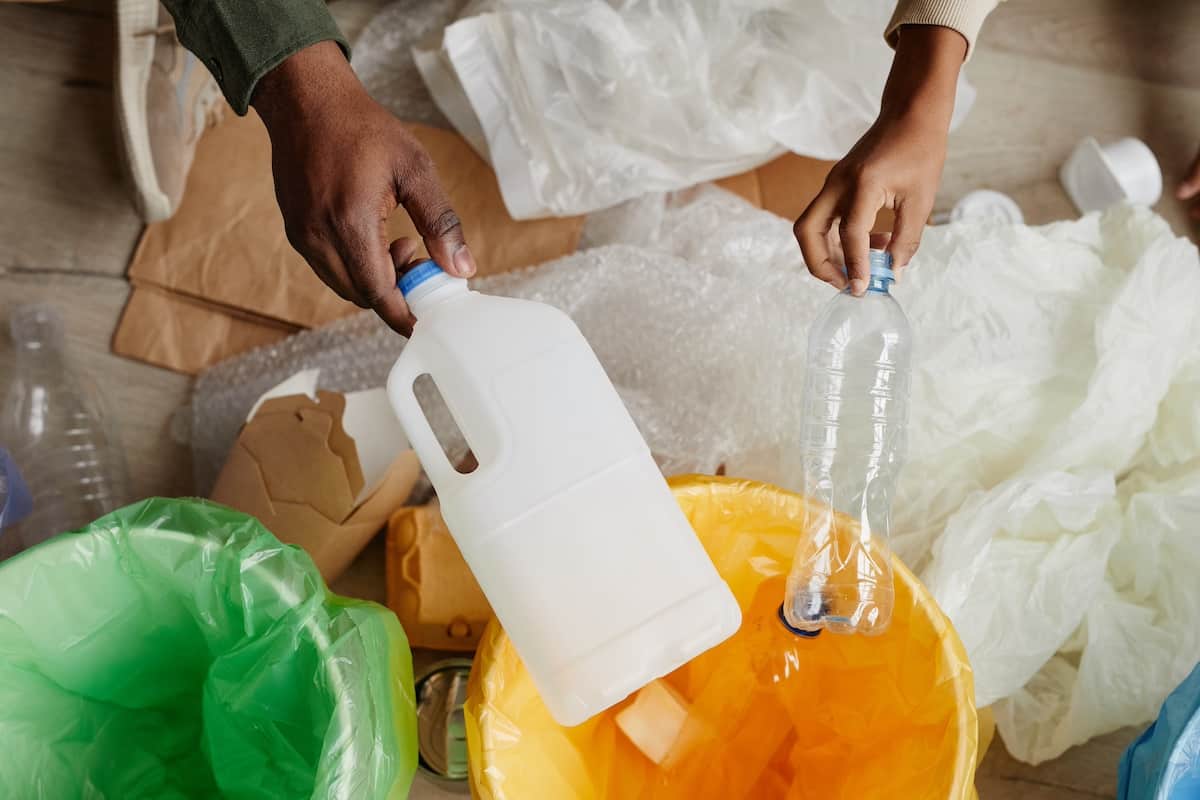Often hiding in plain sight within everyday objects, High-Density Polyethylene (HDPE) is a type of plastic notable for its strength, durability, and versatility. From food storage containers to laundry detergent bottles, HDPE Recycling plays a significant role in our daily lives.
However, alongside its ubiquity comes the challenge of managing HDPE waste, a topic warranting careful analysis considering the immense environmental implications. This article embarks on an exploration of HDPE – its characteristics, recycling processes, environmental impacts, and the potential for technological advancements to incite change.
HDPE – An Overview
Unveiling the Mysteries of High-Density Polyethylene
High-Density Polyethylene (HDPE), is a name that may not roll easily off the tongue but is undoubtedly a central element of our everyday existence. From packaging items, and automotive parts, to intricate medical devices, HDPE plays a significant role in our lives, though its contribution often goes unnoticed.
Primarily, HDPE is a form of plastic derived from petroleum. An intricate process of fractional distillation separates hydrocarbon sections in crude oil and natural gas, essentially leading to the birth of HDPE from the petrochemical ethylene.
Dependent on the exact conditions and catalysts used, the polymerization of ethylene results in varying densities of polyethylene, with high-density variants being the most sought-after due to their desirable properties.
Environmentally Robust
HDPE is renowned for its environmental and mechanical robustness. A key explanation for its prevalent usage lies in its superior tensile strength and high impact resistance, mimicking the durability of heavyweight boxers in the realm of materials, a characteristic attained through its closely packed polymer chains.
uch fortitude has fashioned HDPE into a reliable choice where resilience is necessitated, such as in the manufacturing of outdoor furniture, boat parts, or toys meant to withstand the relentless energy of young aeronautical engineers launching them into the stratosphere.
Lightweight
Moreover, HDPE is notably lightweight – a paradox given its robustness – a property it owes to its low material density. Given this characteristic, HDPE is a favorite for packaging utility, reducing transportation costs and carbon footprint, a growing importance in today’s environment-conscious world.
High Chemical Resistance
Yet another critical designation of HDPE’s popularity pertains to its high chemical resistance. With an innate resilience to many solvents and acids, HDPE forms an impervious shield against corrosive elements, defending the valuable substances it wraps with resolute steadfastness. This invaluable attribute has catapulted HDPE into the pharmaceutical and agricultural industry, safeguarding medication and pesticides with equal efficacy.
Manipulative Flexibility
Furthermore, HDPE’s manipulative flexibility offers manufacturers the liberty to engineer it into a myriad of shapes and sizes. Its malleability has led to a broad spectrum of utilities inclusive of, but not confined to, stormwater pipes, milk jugs, laundry detergent bottles, and shopping bags.
Sustainable
Along with its remarkable traits, HDPE is a champion in sustainability, offering full recyclability. This non-leaching polymer is food-safe and bears a lesser ecological footprint compared to its plastic peers. Its capacity for multiple life cycles without significant quality degradation or toxicity makes it an eco-friendly choice in a world pressing towards valuing circular economy practices.
In conclusion, High-Density Polyethylene is an unsung hero amongst materials, vital in the preservation, protection, and provision of a plethora of goods. It’s fair to say that whether we realize it or not, we are living in a world where HDPE plays a silent yet substantial part in materializing our modern lifestyle’s conveniences.

HDPE Waste Management and Recycling
Delving deeper into the management and recycling of High-Density Polyethylene (HDPE), it becomes clear that various steps are involved in transforming used HDPE items into reusable materials.
Indeed, the potency of modern technology in combination with forward-thinking recycling processes has opened up a fascinating world in which HDPE moves seamlessly through stages of reclamation, reprocessing, and reincarnation.
Collecting and Sorting
To start, the HDPE recycling process begins with the collection and sorting of HDPE materials, usually from recycling bins or designated collection points. These materials range widely from milk containers to detergent bottles, each identified by a recycle symbol and the number ‘2’ inside it. Given the heterogeneity of these products, it is vital to segregate HDPE from other types of waste during initial waste sorting procedures.
Cleaning
Following the sorting phase, the HDPE resins are washed and cleaned to remove any unwanted residues, labels, or adhesives. This is a crucial part of the process – purification ensures that future items made from this physicist’s favorite plastic remain high quality.
Shredding
The cleaned HDPE is then sent to a shredder, which breaks down the HDPE items into small fragments. The fragments are later separated by density in a flotation tank, the physics of buoyancy helping efficiently and cost-effectively separate high-density fragments from low-density materials such as caps and labels.
Extrusion
The next step introduces us to the tantalizing world of thermodynamics, as the separated HDPE fragments are subjected to high temperatures to transform them into malleable plastic granules. The heating and cooling process, known as ‘extrusion’, melts the HDPE fragments into a uniform mass, and cools it rapidly into pellets or “nurdles.”
These HDPE pellets bear a remarkable resemblance to their initial petroleum-derived raw material form, opening up a world of possibilities for their reincorporation into the manufacture of an array of durable goods. From pipes to playground equipment and even newer HDPE containers, it isn’t an exaggeration to say that the potential of the humble HDPE ‘nurdle’ is almost infinite.
The circular nature of HDPE recycling reflects the monumental strides that have been taken in material science. It signals hope for the achievement of a more sustainable future in which plastics like HDPE, ingeniously managed, play a key role. As we continue to develop and improve recycling technologies, the impact on our environmental footprint can be not only measured but also remarkably reduced.
It’s quite fascinating, is it not, how these intricate processes can transform what once was seen as waste into a key element of everyday commodities? This is but a mere snippet of the grand saga that is HDPE recycling and management, a field that promises plenty more chapters, each as exciting as the last.
Environmental Implications of HDPE
Having delved into the benefits of high-density polyethylene (HDPE) and its vast applications in modern life, it becomes important to address the remaining concerns regarding this crucial material. This includes its environmental implications, the challenges of its disposal, and potential solutions to these problems.
The tenacity and resistance to degradation that makes HDPE valuable as a material also render it environmentally problematic. Because it is extremely resistant to the natural processes of decay and biodegradation, HDPE can continue to occupy space in our environments for centuries after use, potentially leading to significant pollution. HDPE mainly ends up in landfills, contributing to the mounting issue of global solid waste.
Worse still, HDPE is frequently mismanaged after disposal, becoming litter in ecosystems across the world. When discarded into bodies of water, HDPE can dangerously interfere with marine life, even leading to death when mistaken for food.
Chemical Resistance of HDPE
Additionally, though the chemical resistance of HDPE is usually a boon, this quality could result in extensive harm when the material becomes a conduit for pollutant transport in water systems.
Yet, despite these challenges, the environmentally responsible handling of HDPE is far from a lost cause. A key part of addressing the issue lies in promoting regular recycling activities. However, this call to action faces a significant hurdle—many recycling programs presently exclude HDPE due to its weight and size.
As a result, most disposed HDPE are currently not being processed for recycling, which underscores the necessity to enhance recycling infrastructure to accommodate and encourage HDPE recycling.
Optimistically, breakthroughs in recycling technology are offering potential solutions. For instance, innovative “advanced recycling” methods pose a promise for the future.
In essence, these techniques revert HDPE to its original petroleum form, ready for fresh conversion into plastics. On the other hand, eco-industrial parks—industrial systems wherein waste from one company serves as another’s raw material—can find alternative reuse for non-recyclable HDPE.
Public Perception of HDPE Recycling
Important to note, too, is that public perception and behavior greatly influence the success of these initiatives. Therefore, community education about HDPE and its environmental impacts should be prioritized alongside attempts to improve recycling technologies and processes.
So, while the use of HDPE presents undeniable environmental challenges, the situation is not irredeemable. A heightened commitment to recycling, coupled with advancements in recycling technology and a conscious shift in public behavior, presents a balanced approach toward mitigating the environmental impact of HDPE. As a society, we must continue to explore and embrace these viable solutions to secure a sustainable future.

Inciting Change in HDPE Recycling
Building upon the comprehensive understanding of High-Density Polyethylene (HDPE), its properties, applications, and recycling processes, it is essential to delve deeper to address the environmental impact. Discussed herein is the confluence of science, technology, and HDPE management towards environmental preservation.
Environmental implications encompassing HDPE vastly relate to its non-biodegradable character. When discarded improperly, these plastics linger in the environment for hundreds of years, leading to soil infertility and water pollution. Furthermore, incineration of HDPE produces harmful greenhouse gases which contribute to global warming.’
Challenges in HDPE Disposal
Challenges in HDPE disposal lie not only in its durability but also in separation and collection. HDPE blends with other materials cannot be recycled without prior sorting, proving laborious and costly. This poses a significant challenge to waste management authorities attempting to efficiently bank on HDPE’s recyclability.
Solutions for HDPE Recycling
Potential solutions have emerged primarily guided by science and technological advancements. Innovations aim at more efficient recycling processes, aiming to maximize the utilization of recycled HDPE, reducing dependence on raw materials. One such breakthrough is the utilization of near-infrared spectroscopy (NIR) for quick and accurate sorting, leading to increased recycling rates.
An equally promising solution is the establishment of eco-industrial parks. These favor reusing non-recyclable HDPE, transforming waste into useful energy through advanced techniques such as pyrolysis. Such practices not only reduce landfill waste but also contribute to energy generation.
However, technology alone cannot solve this issue. Change in the public perception and behavior is indispensable. Thus, the inclusion of HDPE in regular recycling programs – arranged by governmental or non-profit organizations – is necessary. Incentives for proper disposal not only conscious disposal of HDPE products but also encourage participation in recycling programs.
HDPE Recycling Education
Community education is the fulcrum of this paradigm shift. Insight into HDPE and its effects on the environment instills a sense of responsibility and harnesses grassroots-level participation, making it a successful tool for sustainable HDPE management.
Moving forward, mitigating HDPE’s environmental impact necessitates a balanced approach. Striking a balance between production, usage, and disposal can be achieved through sustainable practices such as reuse and recycling complemented by advanced technological inputs.
Last but not least, exploring and embracing plausible solutions is quintessential for a sustainable future. Studies and experiments are constantly paving paths for potential breakthroughs, promising a prospective, environmentally friendly future with HDPE.
All things considered, the intricate weave of science and technology, HDPE management, and human participation and adaptation can indeed curb HDPE’s environmental impact. As with every scientific advancement, perseverance, and continuous adaptation to new knowledge are the torchbearers of progress. Thus, together, moving towards an environmentally friendly trajectory powered by innovation and informed choices seems plausible and closer than ever.
HDPE Recycling: Final Thoughts
Embracing the science and technology at our disposal promises a sustainable future in managing HDPE’s lifecycle. Through innovations and advancements, we stand the chance to transform the current scenery of our waste management systems and counter the environmental impacts of HDPE.
Continual understanding, research, and action on the recycling of HDPE will allow us to align with our ecological responsibilities while still reaping the benefits this versatile material provides. Through collective effort, we can thus envision a future where HDPE could be a part of the solution and not the problem.





